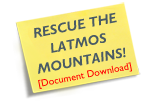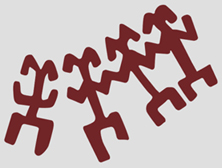




















The rock paintings found by Anneliese Peschlow Bindokat beginning in 1994 in the Latmos Mountains, the range in western Turkey today known as Beşparmak, are among the great new discoveries of Anatolia’s prehistoric archaeology of the past decades. The documentation and systematic study of these paintings are a part of the field work in this region that has been conducted for many years in the name of the German Archaeological Institute (DAI). The aim of this work is to record the traces of human life in this mountain region, formerly located directly on the Aegean coast, from the beginnings until the Ottoman period, and to evaluate it historically. The starting point for this was the Hellenistic town of Heraclea on Latmos at the foot of the mountain range.
The work was carried out with the approval generously granted by the Turkish Ministry of Culture (T.C. Kültür ve Turizm Bakanlığı) and supported by the German Research Association (DFG), the German Archaeological Institute (DAI) and the Gerda Henkel Foundation. I would here like to express my thanks to these institutions. In addition my special thanks go to Prof. Dr. Harald Hauptmann, who followed the rock paintings project with great interest right from the outset, always accompanying it with his expert advice. The work on the site could not have been carried out without the energetic assistance of graduate archaeologist Murat Gülyaz who prepared the copies of the numerous rock paintings. Dr. Volker Höhfeld was an indispensable collaborator for the undertaking over many years as cartographer and geographer. Not to be forgotten are the many Turkish friends in the mountain villages who again and again guided us willingly to new find spots; here we may mention by name Erdinç Yıldırım and İbrahim Kamacı. They are all included in my thanks.
The rock paintings of Latmos represent a new province of rock art in the Near East. Their date from the late Neolithic era until the Chalcolithic age (6th-5th millennium bc) can for the most part be regarded as certain. This self-contained world of pictures linked to the rocky landscape of Latmos stylistically as well as thematically is unique within rock pictorial art, not just in Anatolia, and can therefore be described as a new culture, as the Latmos culture. In contrast to the Ice Age Franco-Cantabrian cave paintings in western Europe, which are dominated as is well known by representations of animals, the main subject of the Latmic imagery is the human being, however not as an individual, but as a member of human society. In this connection, the relationship between the sexes is in the foreground, as is to be recognised by the numerous portrayals of couples of men and women. It is a question of the family and its continued existence, or in a figurative sense about fertility. The location of the rock paintings round the peak of the Latmos, the centre of an ancient Anatolian rain and thus fertility cult, speaks for such an interpretation.
The importance of the Latmic rock paintings for the prehistoric archaeology of Anatolia and the early Aegean period can best be conveyed in Harald Hauptmann’s words. ‘The singular pictorial language of Latmic rock art represents a new world of religious symbols of a society that had become settled and lived increasingly from farming and stock-breeding. This new form of life which spread from the mountainous periphery of the Fertile Crescent, the southern Levant and Upper Mesopotamia through Central Anatolia to the West in the Aegean to Europe, found its special expression in the Latmic rock pictures quite unlike anywhere else in Anatolia. The western coast of Anatolia thus not only forms a transitional zone between the Levantine-Upper Mesopotamian and Central Anatolian area in the East and the Neolithic-Chalcolithic centres of the Aegean in the West, but now acquires a character of its own through these pictures’.
In order to make the rock paintings of the Latmos known to a wider public, a touring exhibition was conceived by the German Archaeological Institute. This exhibition was opened in Berlin in January 2003 and then went through various locations in Germany (Bonn, Freiburg, Olden-burg) and Italy (Rome, Lecce, Naples, Ferrara, Erto, Bolzano). Through the good offices of the former governor of the Province of Muğla, Dr. Lale Aytaman, and with the support of the then Ambassador of the Turkish Republic to Germany, Mehmet Ali İrtemçelik, as well as above all the Vehbi Koç Foundation under its Chairman Ömer Koç, it was possible to bring the exhibition to Turkey where it was to be seen in Istanbul, Ankara, and finally in Muğla. Afterwards it was handed over as a gift from the German Archaeological Institute to the Turkish Republic. Since the beginning of 2010 the exhibition has found its final place in the newly opened museum of the University of Muğla.
Originally it was planned to show the exhibition in further European and non-European countries; however, this idea had to be given up for reasons of cost. Instead it was decided to revise the accompanying original pictures and texts and to place them in the Internet. In this way it is intended to make the world of pictures of the Latmos Mountains, which are equally fascinating for specialists and the lay public, accessible to a wider audience than previously and to stimulate discussion about them anew.
Publications on the rock paintings:
 Anneliese Peschlow-Bindokat, Frühe Menschenbilder. Die prähistorischen Felsmalereien des Latmos-Gebirges (Mainz, Ph. v. Zabern 2003) ISBN 3-8053-3001-4.
Anneliese Peschlow-Bindokat, Frühe Menschenbilder. Die prähistorischen Felsmalereien des Latmos-Gebirges (Mainz, Ph. v. Zabern 2003) ISBN 3-8053-3001-4. -, Antiche immagini dell’uomo. Le pitture preistoriche del Latmo (Mainz, Ph. v. Zabern 2003) ISBN 3-8053-3277-7.
-, Antiche immagini dell’uomo. Le pitture preistoriche del Latmo (Mainz, Ph. v. Zabern 2003) ISBN 3-8053-3277-7. -, Tarihöncesi İnsan Resimleri. Latmos Dağları’ndaki Prehistorik Kaya Resimleri (2. erw. Aufl., İstanbul Zero Prod. Ltd. 2006) ISBN 975-6959-16-9.
-, Tarihöncesi İnsan Resimleri. Latmos Dağları’ndaki Prehistorik Kaya Resimleri (2. erw. Aufl., İstanbul Zero Prod. Ltd. 2006) ISBN 975-6959-16-9. -, The Gods of the Latmos: Cult and Rituals at the Holy Mountain from Prehistoric to Byzantine Times, in: Sacred Landscapes in Anatolia and Neighboring Regions. Ed. by Ch. Gates, Jacques Morin, Thomas Zimmermann. BAR Int. Ser. 2034 (Oxford 2009) 55 - 62.
-, The Gods of the Latmos: Cult and Rituals at the Holy Mountain from Prehistoric to Byzantine Times, in: Sacred Landscapes in Anatolia and Neighboring Regions. Ed. by Ch. Gates, Jacques Morin, Thomas Zimmermann. BAR Int. Ser. 2034 (Oxford 2009) 55 - 62. -, Das Gebirge als Lebensraum. Zur kultischen Bedeutung und profanen Nutzung der Höhlen und Überhänge des Latmos im 6. und 5. Jahrtausend v. Chr., in: Stable Places and Changing Perceptions: Cave Archaeology in Greece. Ed. by F. Mavridis, J.T. Jensen. BAR Int. Ser. 2558 (Oxford 2013) 285 - 305.
-, Das Gebirge als Lebensraum. Zur kultischen Bedeutung und profanen Nutzung der Höhlen und Überhänge des Latmos im 6. und 5. Jahrtausend v. Chr., in: Stable Places and Changing Perceptions: Cave Archaeology in Greece. Ed. by F. Mavridis, J.T. Jensen. BAR Int. Ser. 2558 (Oxford 2013) 285 - 305. Anneliese Peschlow-Bindokat - Christoph Gerber, The Latmos-Beşparmak Mountains. Sites with Early Rock Paintings in Western Anatolia, in: The Neolithic in Turkey. New Excavations & New Research 4. Western Turkey. Ed. by M. Özdoğan, Nezih Başgelen, Peter Kuniholm (İstanbul 2012) 68 - 131.
Anneliese Peschlow-Bindokat - Christoph Gerber, The Latmos-Beşparmak Mountains. Sites with Early Rock Paintings in Western Anatolia, in: The Neolithic in Turkey. New Excavations & New Research 4. Western Turkey. Ed. by M. Özdoğan, Nezih Başgelen, Peter Kuniholm (İstanbul 2012) 68 - 131.Publications on the overall project:
 Anneliese Peschlow-Bindokat, Der Latmos, eine unbekannte Gebirgslandschaft an der türkischen Westküste (Mainz, Ph. v. Zabern 1996) ISBN 3-8053-1994-0, ISBN 3-8053-2006-X (Sonderhefte der Antiken Welt).
Anneliese Peschlow-Bindokat, Der Latmos, eine unbekannte Gebirgslandschaft an der türkischen Westküste (Mainz, Ph. v. Zabern 1996) ISBN 3-8053-1994-0, ISBN 3-8053-2006-X (Sonderhefte der Antiken Welt). -, Herakleia am Latmos. Stadt und Umgebung (İstanbul, Homer Kitabevi 2005) ISBN 975-8293-72-9.
-, Herakleia am Latmos. Stadt und Umgebung (İstanbul, Homer Kitabevi 2005) ISBN 975-8293-72-9. -, Herakleia. Şehir ve Çevresi (İstanbul, Homer Kitabevi 2005) ISBN 975-8293-73-7.
-, Herakleia. Şehir ve Çevresi (İstanbul, Homer Kitabevi 2005) ISBN 975-8293-73-7. -, Herakleia On The Latmos (İstanbul, Homer Kitabevi 2014) ISBN 978-9944-483-63-6.
-, Herakleia On The Latmos (İstanbul, Homer Kitabevi 2014) ISBN 978-9944-483-63-6. -, Feldforschungen im Latmos. Die karische Stadt Latmos. Milet Bd. III, 6 (Berlin / New York, de Gruyter 2005) ISBN 978-3-11-018238-5.
-, Feldforschungen im Latmos. Die karische Stadt Latmos. Milet Bd. III, 6 (Berlin / New York, de Gruyter 2005) ISBN 978-3-11-018238-5.








































